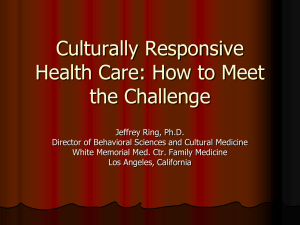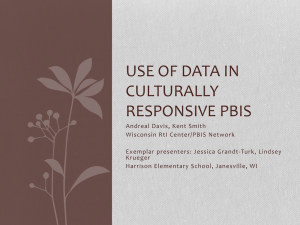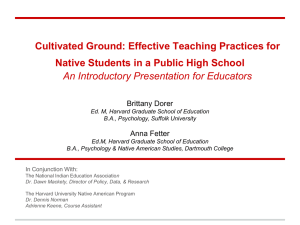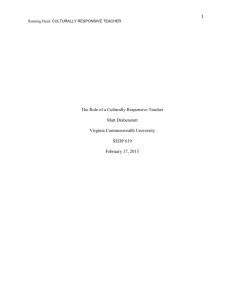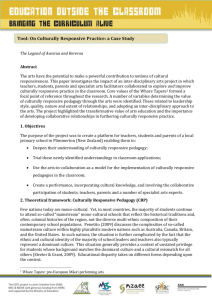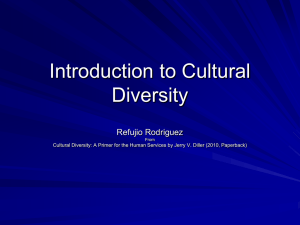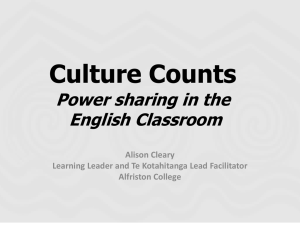Culturally Responsive Pedagogy Paper
advertisement
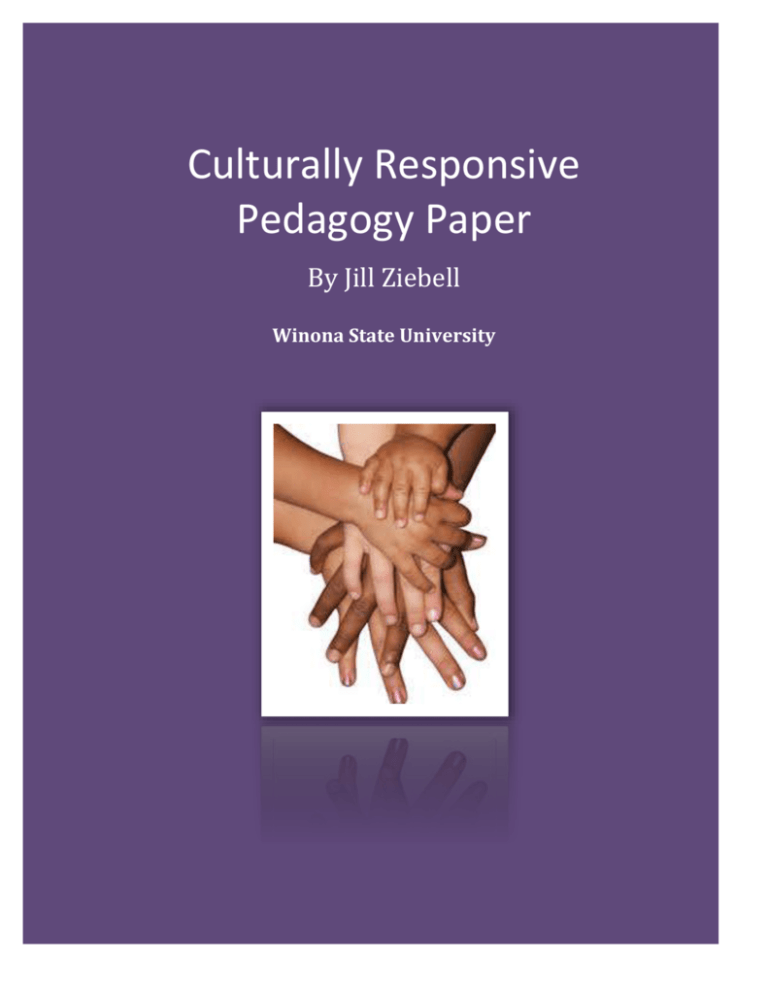
Culturally Responsive Pedagogy Paper By Jill Ziebell Winona State University Culturally Responsive Pedagogy Paper 1) Why do we need address diversity? The MN Standard of Effective Practice (2010) states that a teacher must understand how students differ in their approaches to learning and create instructional opportunities that are adapted to students with diverse backgrounds and exceptionalities. The teacher must know about the process of second language acquisition and about strategies to support the learning of students whose first language is not English. Another reason we need to address diversity outlined by the MN Standards of Effective Practice is that a teacher must also understand how to recognize and deal with dehumanizing biases, discrimination, prejudices, and institutional and personal racism and sexism. The teacher must understand how experiences, talents, and prior learning, as well as language, culture, family, and community values, influence a student’s learning. A teacher must also realize how lifestyles of the various racial, cultural, and economic groups in our society contribute to learning. Teachers must be able to incorporate aspects of each students life into his/her instruction, including culture, families, and communities. Teacher must also connect student experiences to instruction in order to bring multiple perspectives into the classroom. Today many classrooms consist of students from diverse backgrounds. As efforts mount to identify teaching methods to meet the requirements of diverse classrooms, the need for pedagogical approaches to meet these diversities grows. According to the Department of Education (2006), today’s educators are required to instruct students that vary by culture, language, ability, and many other characteristics. Culturally responsive pedagogy is a now required to meet the needs of the diverse classroom. This classroom must also welcome and support students from diverse background and prove an opportunity for all students to learn. 2) What is culturally responsive pedagogy? The Wisconsin Department of Public Instruction (2008) describes culturally responsive pedagogy as having inclusive content covered in the curriculum, reflecting societies diversity. Being culturally responsive allows students to see themselves as well as their experiences in the curriculum. Students are able to build on their own prior knowledge, including their culture and language. Pedagogy is also based on the premise that culture inclusiveness is necessary to students learning because there is strong evidence that thought processes are linked to cultural practices. The success of all students is encouraged by culturally responsive pedagogy. Effective teaching and learning occur in a culturally supported, learner-centered context. The strengths of each student are acknowledged, utilized, and given the opportunity to grow, creating greater successes. 3) What are some elements of culturally responsive teaching? The Wisconsin Department of Education (Burmaster, 2008) describes the three components to determine cultural responsive pedagogy. Culturally responsive pedagogy comprises institutional, personal, and instructional dimensions. The institutional dimension reflects the policies schools adhere to and value. The personal dimension refers to the cognitive and emotional processes teachers must engage in to become culturally responsive. The instructional dimension includes materials, strategies, and activities that form the basis of instruction. All three dimensions significantly interact in the teaching and learning process and are critical to understanding the effectiveness of culturally responsive pedagogy. Wisconsin Department of Public Education, in Resources for Culturally Responsive Instruction and Pedagogy (Burmaster, 2008), goes on to say that in order to culturally responsive teachers must include: communication of high expectations, active teaching methods that promote student engagement. Teachers must also create a positive perspective on parents and families of culturally and linguistically diverse students. Reshaping the curriculum so it is culturally responsive to the background of students is also critical for culturally responsive instruction. Such instruction, as described by Wisconsin Department of Public Education (2008), is characterized by the use of culturally mediated cognition, culturally appropriate social situations for learning, and culturally valued knowledge in curriculum content, a student controlled classroom discourse, and small group instruction and academically-related discourse. 4) Why is cultural proficiency important? In Saint Paul Public Schools (2010), cultural proficiency is defined as the values, beliefs and behaviors that enable individual employees of the district to interact effectively with culturally diverse students, staff, and families and the broader community. The intended outcome of becoming a culturally proficient organization is that the vision, values, policies and practices allow for effective cross-cultural interactions among and between students, staff, families and the broader community. Cultural proficiency reaches across all district roles and responsibilities. It reaches inward, into classes and staff lounges and hallways---it reaches outwards, into homes and extended families and communities. St. Paul Public Schools (2010) goals of the Professional Development toward cultural proficiency are threefold. The first is to provide all teachers with the tools they need to be more culturally proficient in the work they do everyday. The second goal is to reach out to all students and their families and in order to raise achievement and close the achievement gap within the school. The final goal of becoming culturally proficient is to create a welcoming environment throughout the district so both employees and community members feel respected and welcomed. 5) The Institutional Dimension: What Must the Educational System Do? In a practitioner brief he National Center for Culturally Responsive Educational System (2006) describes three specific areas that must be addressed in order to create a culturally responsive school. The first area to addressed is the administrative structure and the way it relates to diversity, and the use of physical space in planning schools and arranging classrooms. School policies and procedure must also be addressed. This refers to those policies and practices that ensure services to students from diverse backgrounds. Community involvement is the final component in the institutional dimension of becoming culturally proficient. This concerns how the school approaches community members and finds ways to involve them in the school. School must find ways to make connections with families and community member in order to make them feel like a valuable part of the school. NCCREST goes on to say that although all three areas in the institution must become more culturally responsive, a particular concern is the impact of school policies and procedures on the allocation of resources. Some things to consider are teacher assignments, course opportunities, and resource allocation. The schools must critically look at the relationship between polices and practices, and how the relate to the diverse students and the community as a whole. 6) The Personal Dimension: How Do Teachers Become Culturally Responsive? NCCrest (2006) also describes how a teacher becomes culturally responsive. The first step in becoming culturally responsive is with self-reflection. A teacher must honestly examine their attitudes and beliefs about themselves and others, and the effects these beliefs have on others. Teachers begin to discover why they are who they are, and can confront biases that have influenced their value system. Because biases impact attitudes and relationships with students and their families, teachers must reconcile negative feelings towards any cultural, language, or ethnic group. NCCrest goes on to say that many teachers find it hard to accept that their values reflect prejudices or racism toward any group. Once teachers look at themselves critically they are able to rid themselves of such biases. They are then able to create a learning environment of trust and acceptance for students and their families, resulting in greater opportunity for student success. Another important aspect of the personal dimension is exploration. Teachers must explore their own histories as well as the histories of their students. Teachers must get to know the cultural experience of their students as well as their family values. This will give the teacher a deeper understanding of self and others and a greater appreciation of differences. An unbiased teacher is better able to meet the needs of all students in the classroom, resulting in greater successes. 7) List Specific Activities for Becoming a Culturally Responsive Teacher Geneva Gay (2002), in an article entitled Preparing for Culturally Responsive Teaching, gives activities teachers can do to become culturally responsive. The first activity she suggests is developing a cultural diversity knowledge base. This knowledge includes cultural characteristics and contributions of different ethnic groups. Teachers must also have knowledge of cultural values, traditions, communication, learning styles, contributions, and relational patterns and understand the impact these things have on learning. The next activity describes by Gay is demonstrating cultural caring and building a learning community. This includes creating a learning environment that this conducive to learning of ethnically diverse students. This is done using the student’s own culture and experience to expand their academic achievements. Teachers must be truly concerned from all their students. Teachers must have high expectations for their students and work diligently to help them accomplish these expectations. NCCREST (2006) also suggest several additional activities a teacher should do to become culturally responsive. These include engaging in reflective thinking and writing about own behaviors, visiting students’ families and communities, visiting or reading about successful teachers in diverse settings, and participating in reforming the institution. 8) The Instructional Dimension: How Does Instruction Become Culturally Responsive? Geneva Gay (2002) includes the instructional dimension in her journal article, Preparing for Culturally Responsive Teaching. Gay suggests designing culturally relevant curricula. She says it is import for teachers to convert knowledge about cultures into instructional strategies. Teacher must look at instructional materials and strategies and determine the multicultural strengths and weaknesses and make changes to improve the overall quality of instruction. Teachers must analyze material for accuracy, complexity, placement, purpose, variety, significance, authenticity, illustrations, learning activities, role models, and sources. Gay also suggests that cross-cultural communication is important to create culturally responsive instruction. Included in this are “what we talk about; how we talk about it; what we see, what we attend to, and what we ignore; how we think; and what we think about. Instruction must take into account the communication styles of different ethnic groups and how they reflect cultural values. They must shape their instruction to accommodate these behaviors differences in order to improve the success of the diverse students. Cultural Congruity in classroom instruction is the last aspect Gay discusses in her journal article. Culture is deeply embedded in any teaching; therefore, instruction has to reflect the culture of each student. Instructional techniques must match the learning styles of diverse students. Cultural characteristics should be used to modify instruction to meet the needs of the students. 9) Specific Activities for Culturally Responsive Instruction The National Center for Culturally Responsive Educational System (2006) gives specific activities in culturally responsive instruction. The first is to acknowledge the student’s differences as well as their commonalities. Teachers should not predetermine a particular characteristics to a student based solely on his/her ethnic or racial group. Each student has unique qualities and learning needs. A teacher who realizes these differences is better prepared to meet the individual needs of each student. NCCrest also suggests validating students’ cultural identity in classroom practices and instructional materials. It is important that all classroom materials and instruction support the students, are free of stereotypes, and capitalize on the strengths of the students. It is also important to educate students about the world around them and promote equity and mutual respect among students. Another activity described by NCCrest is the assessment of students. The assessment of students must be accurate and sensitive to the student’s cultural and linguistic background. Teacher must also encourage students to be active in their learning. The must learn to think critically and strive for excellence. Teachers must expect the same from them. The last activities described are fostering a positive relationship with students, their families, and the community and assisting students in becoming socially and politically conscious. The interrelation between the school, student, family, and community benefits everyone involved. In order to create a responsible citizen, students must believe the world would be a better place if everyone were treated fairly. They must also believe it is their responsibility to help make this happen. 10) What Are the Implications of Culturally Responsive Pedagogy? NCCREST (2006), in a pamphlet entitled Addressing Diversity in Schools, describes the implication of cultural responsive pedagogy. It states that all students should have an equal opportunity to achieve to the best of their ability. It is the teacher’s responsibility to bring forth their full potential. Instruction must reflect the cultural and linguistic practices and values of all groups of students. Instruction that is culturally responsive addresses the requirements of all learners. The school must use a curriculum that addresses the needs of every students and the teacher must act as an agent of the culturally responsive curriculum. Daily, teachers have and opportunity to make a difference in the students learning and more importantly life. Although the curriculum may be dictated by the school system, teachers teach it. They are a very powerful force in each student’s life. NCCrest goes on to say, “Where the curriculum falls short in addressing the needs of all students, teachers must provide a bridge; where the system reflects cultural and linguistic insensitivity, teachers must demonstrate understanding and support.” In other words, it is the teacher’s responsibility to be culturally responsive. Utilizing materials and examples, engaging in practices, and demonstrating values that include students from all backgrounds is a vital part of this responsibility. Geneva Gay, in The Journal of Teacher of Education, states, “Because culture strongly influences the attitudes, values, and behaviors that students and teachers bring to the instructional process, it has to like wise be a major determinant of how the problems of underachievement are solved.” Resources Burmaster, E. (2008). Resources for culturally responsive instruction and pedagogy. Retrieved September 10, 2010, from State of Wisconsin Department of Public Instruction website: http://dpi.wi.gov/sped/doc/disp-res-cultural.doc Gay, G. (2002, March/April). Preparing for culturally responsive teaching. Journal of Teacher Education, 53(2), 106-116. NCCrest. (2006). Addressing diversity in schools: Culturally responsive pedagogy [Pamphlet]. U.S. Department of Education. St. Paul Public Schools. (2010, May 27). Welcome to the SPPS cultural proficiency toolkit: A project of the office of educational equity . Retrieved September 21, 2010, from http://culturalproficiency.spps.org/Home.html Standards of Effective Practice for Teachers, (2010) Minnesota Administrative Rule § 8710.2000

